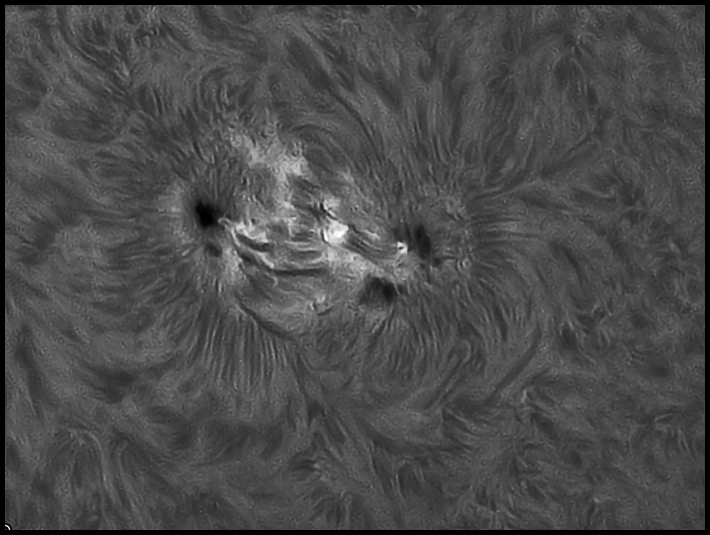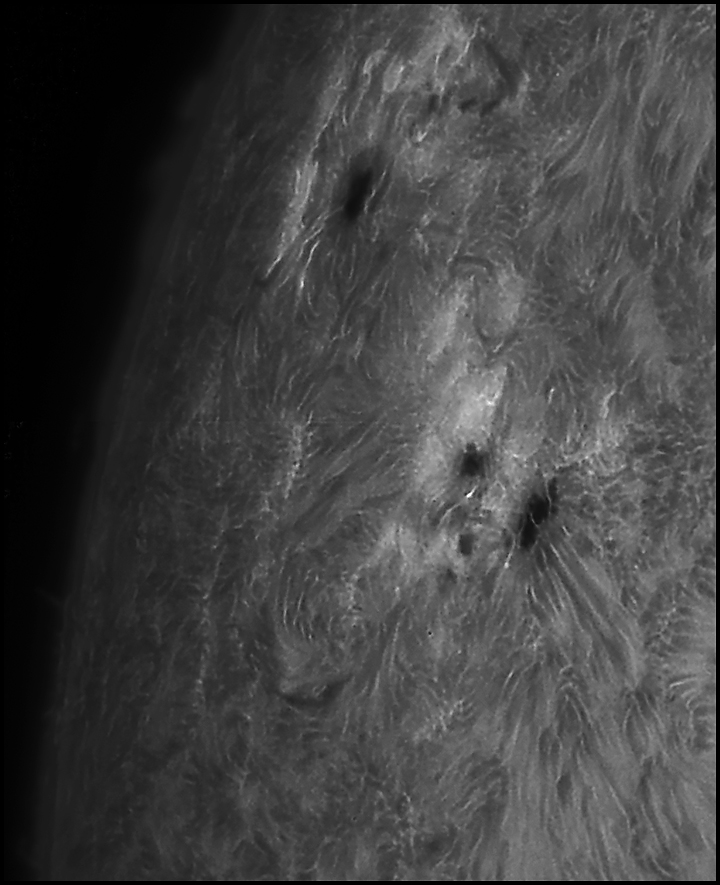|
6/15/2014. I finished staining the porch early this afternoon (except, of course, for the inevitable touch ups) and then celebrated that sweaty job with an even sweatier one. I took the 90mm Frankenscope out for a stroll under an active Sun. First up, a flare factory in a relatively quiescent state, AR 2087:

Gamma 0, gain 45, exp 5ms, best 150 out of 1000 frames

Same tech bits. Mosaic of 3 frames. The image runs E-W but
is presented vertically to make scrolling easier. I think this is AR 2087
(at bottom) and AR 2092, but could be mistaken.
I put these through 40 passes of Pixinsight's LR deconvolution, then adjusted curves, then 10 more passes. All passes were with 13x13 PSFs. A flat made from a defocused 100-frame clip works great to remove dust and other surface atrocities on the chip. I'm not happy with this processing; I need to get much better with Pixinsight; use it to suppress noise and avoid those odd highlights between sharpened greys.
6/30/2014. Bad seeing today inspired me to try severe selection criteria on clips: the best results came from using only the best 20 out of 1,000 frames. To rescue something worthwhile from the day's efforts, I spent some time playing with the deconvolution parms in PixInsight. Here's what I settled on after about 90 minutes of trials:
Parametric PSF
StdDev: 2.80 25x25 (adjust this; take this value as an approximate upper bound)
Shape: 1.1
(<2 approximates diffraction pattern; 2 is Gaussian; >2 is flat topped)
Aspect ratio: 1.00
Rotation: N/A
Algorithm: Regularized Richardson-Lucy
Iterations: 20
Target: Luminance (CIE Y)
Deringing checked
Global dark: 0.1000
Global bright: 0.0300
Local deringing checked
Local support: N/A
Local amount: 0.70
Wavelet Regulariztion checked
Noise model: Poisson
Wavelet layers: 5
Small-Scale(3)
Noise threshold / Noise reduction:
(1) 16.0 / 0.89
(2) 11.8 / 0.54
(3) 4.2 / 0.28
(4) 2.0 / 0.30
(5) 1,6 / 0.32
Convergence: 0.0000 Disabled checked
I do not for a moment think those are the best available settings, but they are better than the defaults when used with the 90mm Frankenscope at its maximum EFL and make a decent starting point. See:

Gamma 0; 7ms; gain 45 db
Best 20 of 1,000 frames
The irritating, spurious bright lines between over-sharpened grey regions seem almost absent or at least very much reduced. The short stack left the noise "louder" than I would prefer. The PixInsight settings are stored as a "project" under the name "90mm Solar Long EFL" in the directory "Photo-related/2014/solar". FWIW, I updated to PixInsight 1.8.4 before undertaking these trials.

2-frame mosaic, same exposure and post-proc
except best 100 of 1,000 frames
July 2, 2014. Same active regions and a new one coming around the mountain:

2x2 mosaic, best 50 of 500-frame clips
:: top ::
Except where noted, solar photos are made with a ZWO Optical ASI120MM camera (ca. June 2013) behind a Lunt Solar Systems 60mm THa with its objective replaced by an Orion 90mm F10 achromat. The telescope uses a B600 blocking filter and is mounted piggyback with an Astro-Tech 10-inch Ritchey-Chretien (carefully capped!) on an Astro-Physics Mach1GTO mount. A Dell Latitude notebook running FireCapture provides camera control and capture services via USB 2.0. Images typically begin as 400 - 1200 frame AVI's captured at about 27 fps. Clips are aligned and stacked using AVIStack 2.0. The resulting files are processed via wavelet functions in Registax and / or the FocusMagic 3.0.2 deconvolution plug-in in Photoshop CS4. Alternatively, PixInsight picks up the processing somewhere in the workflow after AVIStack processing. The imaging train usually includes an Orion "Shorty" 2x barlow screwed into the ASI120MM body. A RoboFocus motor with a timing belt looped around the stock (or, sometimes, a Feathertouch) focus knob enables remote operation. | 



